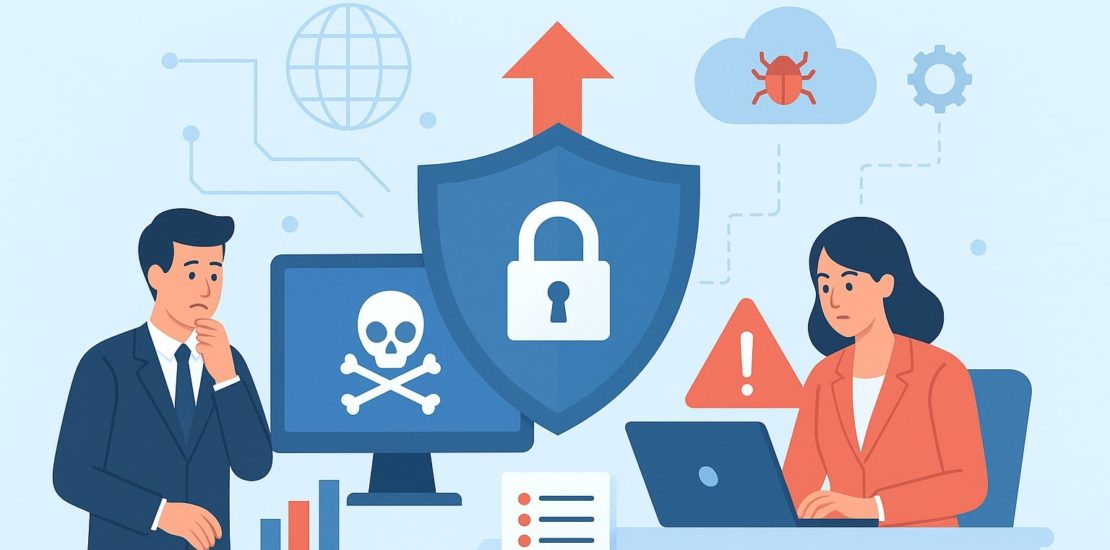ICT Risks Are Rising: How to Stay Ahead
- October 8, 2025
- Posted by: Gradeon
- Category: Cyber Security

In today’s hyperconnected world, information and communications technology (ICT) is the foundation of business operations. Every process, from communication and data storage to customer management, relies on digital systems. However, as technology advances, the risks associated with it are also increasing. Cyber threats, data breaches, and system vulnerabilities are no longer rare incidents—they are everyday challenges that demand proactive management.
A recent Global Cybersecurity Outlook report revealed that more than 70% of organisations have seen a rise in ICT-related risks in the past year. With remote working, AI adoption, and cloud dependency continuing to grow, the threat surface is expanding faster than many businesses can manage.
To stay ahead, organisations need to shift from a reactive approach to a proactive risk management strategy. Let’s explore the key ICT risk trends and how businesses can build resilience.
1. Understanding Why ICT Risks Are Rising
a. Artificial Intelligence and Shadow Tools
AI is transforming operations but also empowering attackers. Cybercriminals are using AI to automate phishing, create deepfakes, and bypass security controls. Meanwhile, employees using unauthorised AI tools, often called “shadow AI,” can expose sensitive company data without realising it.
b. Third-Party and Supply Chain Vulnerabilities
Modern businesses rely heavily on third-party vendors, cloud providers, and IT partners. Each connection introduces potential weaknesses. Even a single compromised supplier can lead to major breaches, as seen in several global supply chain attacks in recent years.
c. Complex Regulatory Landscape
Governments across the world are tightening regulations around data privacy and cybersecurity. While these laws improve overall resilience, they also increase compliance complexity for global companies. Failing to align with frameworks such as GDPR, NIS2, or DORA can lead to legal and financial penalties.
d. The Quantum Computing Challenge
Quantum computing is still developing, but experts warn that once it matures, current encryption standards like RSA could be broken. Preparing for “post-quantum security” is already becoming part of forward-thinking cybersecurity strategies.
e. Growing Ransomware and Data Breaches
Ransomware remains one of the most destructive threats. Attackers are no longer just encrypting data—they are stealing and threatening to publish it. Critical industries such as healthcare, energy, and logistics are especially vulnerable to such double-extortion attacks.
2. Building a Strong ICT Risk Management Framework
Effective ICT risk management requires structure and foresight. The following pillars form the backbone of a strong framework.
a. Identify and Classify Assets
You can’t protect what you don’t know exists. Start by listing all IT assets, including applications, servers, cloud platforms, and third-party integrations. Categorise them by their importance and sensitivity to the organisation.
b. Assess and Prioritise Risks
Conduct regular risk assessments to identify vulnerabilities and their potential business impact. Using a likelihood-impact matrix helps prioritise threats so that resources are directed where they matter most.
c. Implement Layered Security Controls
A multi-layered defence strategy, often called “defence in depth,” helps protect against a wide range of attacks.
Key measures include:
- Adopting a Zero Trust model that verifies every access request.
- Enforcing least privilege access to limit internal movement.
- Using encryption for data at rest and in transit.
- Maintaining strong patch management practices to close known vulnerabilities.
- Integrating DevSecOps to include security checks during software development.
d. Monitor and Detect Threats in Real Time
Real-time monitoring is essential. Use Security Information and Event Management (SIEM) systems, intrusion detection tools, and continuous vulnerability scanning to identify abnormal activity. Implementing Continuous Threat Exposure Management (CTEM) ensures threats are spotted before they can cause damage.
e. Prepare for Incident Response and Recovery
Even with robust protection, incidents can occur. Organisations should maintain and test an incident response plan.
Best practices include:
- Conducting tabletop exercises to simulate attack scenarios.
- Maintaining offline and immutable data backups.
- Performing root-cause analysis after every incident.
- Documenting lessons learned and updating policies accordingly.
f. Embed Security into Governance and Culture
Technology alone cannot eliminate ICT risks. Human awareness and accountability are equally important.
Leaders should:
- Establish a cross-department risk committee.
- Assign clear ownership for cybersecurity and data governance.
- Deliver regular employee training on phishing, password hygiene, and device security.
A strong security culture reduces the likelihood of human error, which remains one of the leading causes of breaches.
3. Practical Steps to Stay Ahead
- Run a full ICT risk audit at least once a year.
- Adopt Zero Trust principles for identity and access control.
- Review vendor security before onboarding new partners.
- Invest in automation for continuous monitoring and compliance reporting.
- Test data backups frequently to ensure recovery capability.
- Educate your workforce with regular cybersecurity awareness sessions.
- Track and report metrics like detection time and incident resolution speed to leadership.
- Plan for the future by exploring quantum-resistant encryption and AI-driven security tools.
4. Moving from Reactive to Resilient
The biggest challenge in ICT risk management is not the lack of tools—it’s the lack of strategy. Many organisations still act only after an incident occurs. This reactive approach is costly and damaging.
Resilience, on the other hand, comes from preparation. Businesses that continuously assess risks, train employees, and modernise their security systems recover faster and maintain customer trust even during disruptions.
Conclusion
ICT risks are growing in scale and complexity, but they can be managed with the right mindset and planning. The goal is not to eliminate every threat—it’s to anticipate and withstand them.
By understanding the evolving threat landscape, implementing layered defences, and fostering a culture of shared responsibility, your organisation can stay one step ahead of cyber risks.
Technology will keep evolving, and so will the risks. The companies that invest in resilience today will be the ones leading confidently tomorrow.
